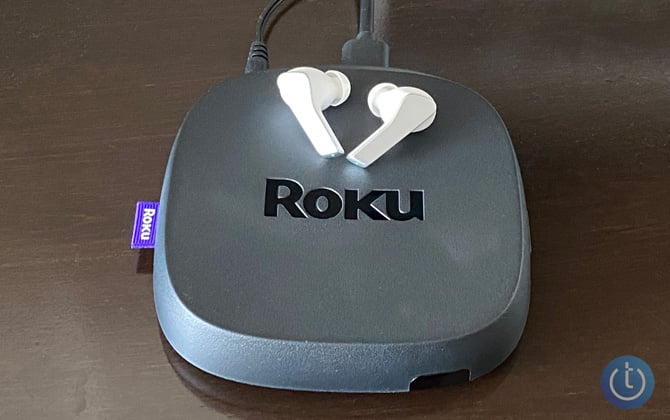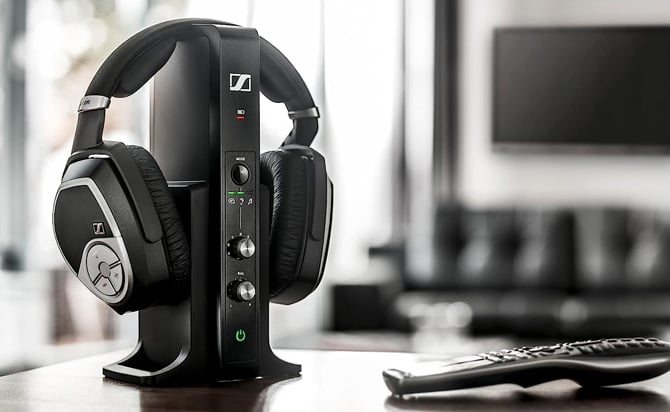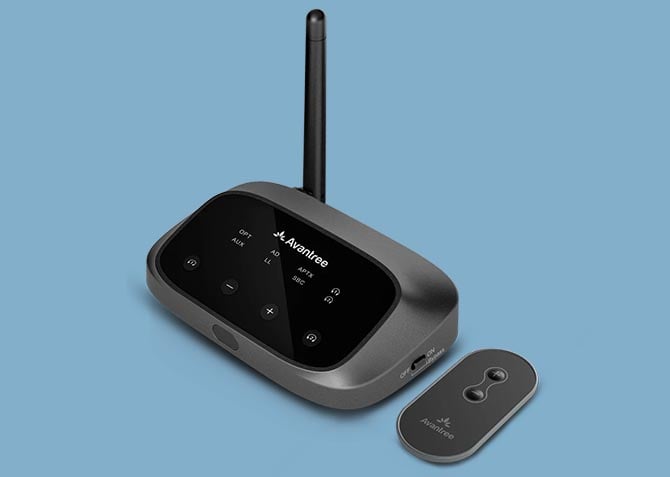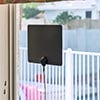We may earn commissions when you buy from links on our site. Why you can trust us.
How to Watch TV with Wireless Headphones
Watching TV with wireless headphones is a great way to enjoy your favorite shows and movies without disturbing others. In my New York City apartment, wearing headphones allows my night-owl husband to catch up on his shows while I sleep. Headphones also also a great option if you want an immersive private audio experience.
Most TVs come with built-in Bluetooth, allowing you to pair headphones directly. If your TV doesn’t have Bluetooth, you can use a streaming device like an Amazon Fire Stick or Roku Player, a Bluetooth transmitter, or even a gaming console like the Nintendo Switch. If you have a soundbar hooked up to your TV, some models allow you to connect Bluetooth headphones for private listening.
No matter what setup you have, there’s a way to get your wireless headphones working with your TV.
Option1: Use your TV's built-in Bluetooth
Most TVs come with built-in Bluetooth, which means you can pair your wireless headphones without needing extra accessories. To check if your TV supports Bluetooth, look in your TV’s settings menu, refer to your TV’s manual, or search for your model online.
How to connect Bluetooth headphones to a TV:
- Put your headphones in pairing mode – usually done by holding the power or Bluetooth button for a few seconds.
- Go to your TV’s Bluetooth settings – this is typically found in the Sound or Connections menu.
- Select ‘Bluetooth Devices’ or ‘Pair New Device’ and choose your headphones from the list.
- Confirm the connection and adjust the audio output if needed.
Some TVs have a dedicated “Bluetooth Audio” mode that helps reduce lag, but if you experience delay issues, a low-latency Bluetooth transmitter may improve synchronization. Also, while many TVs support Bluetooth audio, some only work with specific Bluetooth codecs or brand-specific headphones (e.g., Samsung’s TVs may work best with Samsung Galaxy Buds).
For brand-specific guides, check out how to connect Bluetooth headphones to your TV.
Option 2: Use your streaming media player's built-in Bluetooth

If your TV doesn’t support Bluetooth, your standalone streaming media player might. All current Amazon Fire TV and Google TV streaming media players enable you to pair your Bluetooth headphones with them for private listening. Roku only has Bluetooth in its Ultra series players, Streambars, and Plus Series TVs. But you can use the Roku app to listen with Bluetooth headphones with any model.
I've used all three platforms extensively, and pairing Bluetooth headphones is simple for each. You'll find step-by-step instructions in the following stories:
How to connect Bluetooth headphones to your Roku player
How to connect Bluetooth headphones to your Amazon Fire TV player
How to connect Bluetooth headphones to your Google TV player
Option 3: Use a Bluetooth adapter for your TV
If your TV and streaming media player don't come with built-in Bluetooth, it's easy to add Bluetooth with a simple adapter. The adapter plugs into your TV's audio out, whether it's a 3.5mm headphone jack or an optical out. Pair your Bluetooth headphones with the adapter, and you're ready to listen.
My favorite Bluetooth adapter is the feature-rich Avantree Oasis Plus 2. It supports aptX-Adaptive & Low Latency to prevent lip-sync issues, and it has an extended range, able to transmit audio up to 164 feet – a range that is more than triple most Bluetooth transmitters.
The Oasis Plus 2 is designed to work with a soundbar, with a bypass feature so audio will automatically play on the soundbar if no Bluetooth headphones are in use. You can also use the soundbar and a pair of Bluetooth headphones at the same time if there's someone with hearing loss who needs an extra volume boost. Or, you can transmit audio to two pairs of Bluetooth headphones simultaneously – perfect for when parents want to watch a movie and the kids are sleeping.
Once you're connected, I like the convenience of having multiple options for controlling audio. You can use your headphones, the TV remote, or the buttons on the Oasis Plus 2 box.
The Avantree Oasis Plus 2 retails for $79.99 (check the price Amazon).
Option 4: Connect via your soundbar
If your soundbar has Bluetooth capabilities, you can use it as a middleman between your TV and wireless headphones. Some premium soundbars from brands like Bose, Sonos, and Sony have this feature, allowing you to pair Bluetooth headphones for private listening.
How to connect wireless headphones via your soundbar:
- Check your soundbar’s Bluetooth settings – Some soundbars have both Bluetooth input and output. You need one that supports Bluetooth transmission (output).
- Put your headphones in pairing mode – Just like you would when connecting them to a phone or TV.
- Enable Bluetooth output on your soundbar – The exact steps vary by model, but typically you’ll navigate to Bluetooth settings > Output device > Pair headphones.
- Adjust the audio settings – Some soundbars may allow simultaneous TV speaker and Bluetooth headphone output, while others may switch exclusively to headphones.
This option is especially useful if you already use a soundbar for better TV audio and want a seamless way to switch between speakers and private listening.
Option 5: Dedicated wireless headphones offer a better connection than Bluetooth

When it comes to wireless TV audio, Bluetooth solutions sometimes face interference issues. That's where dedicated wireless headphones, like the Sennheiser RS 195, excel. These headphones use proprietary wireless technology to deliver latency-free, rich audio over long distances – up to 330 feet versus the 30 feet of Bluetooth. If your primary listening mode is through headphones, investing in a dedicated pair like the RS 195 is a wise choice.
The Sennheiser RS 195 stands out for its unparalleled sound quality for TV viewing. These over-ear, closed-back headphones are designed to minimize background noise, allowing you to fully immerse in your favorite shows and music. There are modes tailored for speech and music, and, if you have mild to moderate hearing loss, you can create custom sound profiles.
Read More: The Best Open Ear Headphones You Can Buy Today
Setup is straightforward: plug the transmitter into your TV's standard 3.5mm headphone jack or optical digital audio output, turn on your headphones, and you're ready to go. For homes with multiple users, the RS 195 can connect to a second pair of compatible Sennheiser headphones.
Other professional reviewers and users agree with my assessment – the Sennheiser RS 195 is the top choice for dedicated TV headphones. High ratings on Amazon, Crutchfield, and Best Buy testify to their long-term quality.
The Sennheiser RS 195 retail for $399.95 (check the price of the RS 195 on Amazon).
Option 6: Use your game console
If you have a gaming console, you might be able to use it to watch TV with wireless headphones. While most gaming consoles don’t support direct Bluetooth audio, they often allow you to download apps like Netflix, Hulu, and YouTube, meaning you can stream content directly from your console while using a supported wireless headset.
- Nintendo Switch – Unlike most consoles, the Nintendo Switch natively supports Bluetooth audio. Simply go to System Settings > Bluetooth Audio > Pair Device and connect your headphones.
- PlayStation and Xbox – These consoles don’t have built-in Bluetooth for headphones, but you can use a wired headset with the controller or a USB Bluetooth adapter for wireless functionality. If you have a PlayStation Pulse 3D headset or Xbox Wireless Headset, these connect natively without additional accessories.
While gaming consoles may not be the first thing that comes to mind for TV audio, they can be an effective workaround if your TV lacks Bluetooth support.
Updated on 3/14/2025 with new product recommendations and options for using wireless headphones
[image credit: Avantree, Techlicious, Sennheiser]















